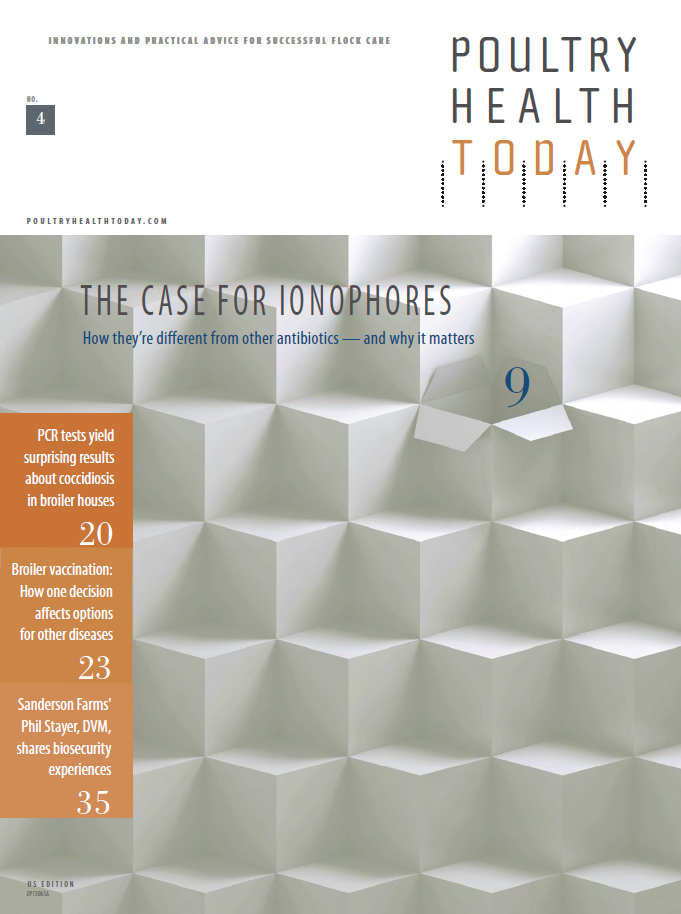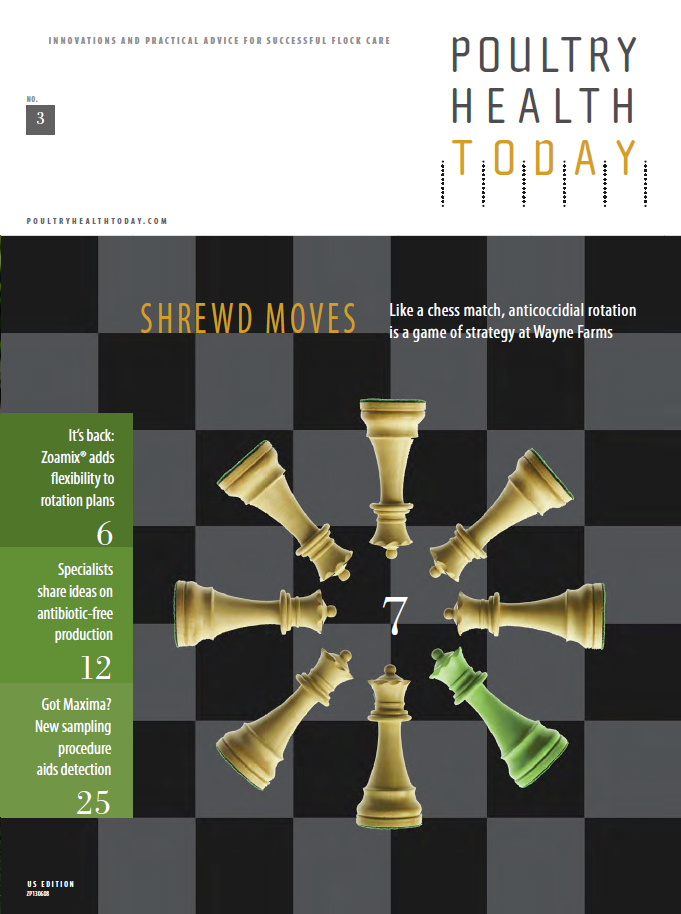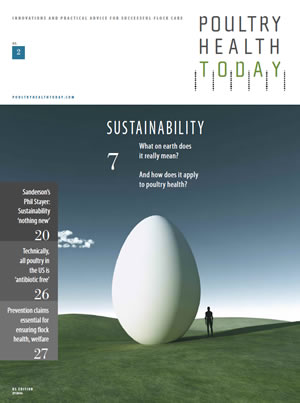

Fast growth seen for ABF poultry production, but for how long?

To see how the antibiotic-free (ABF) production trend is playing out with producers’ plans, Poultry Health Today turned to Greg Rennier, PhD, of Rennier Associates Inc., Columbia, Mo., a poultry-market research specialist who tracks product usage in the industry. Rennier mixes extensive interviews with top poultry complexes, fact checking with industry sources and a proprietary model to compile reports for leading animal-health companies. Poultry Health Today asked the veteran trend-watcher to crunch a few numbers on US broiler antibiotic trends from 2013 to 2015.
Rapid growth of ABF
Rennier reported that 12% of the US broiler-feed tonnage made in 2015* was associated with “no antibiotics ever” programs — a 400% increase over the previous year. Nevertheless, Rennier said, it was equally important to note that while antibiotic usage may be declining, it was by no means going away.
If 12% of broiler feed in 2015 was made specifically for “no antibiotics ever” programs, that means 88% of the feed was produced for birds that were in programs where antibiotics were still fed. While that’s a 9-point drop in antibiotic feeds in only a year, a significant majority of US poultry producers still used antibiotics to prevent, treat and control disease, he said.
Furthermore, a closer analysis of Rennier’s data (Figure 1) reveals that the US poultry industry is shifting its approach to antibiotic usage — not abandoning antibiotics altogether.
Four feed categories
For this report, Poultry Health Today assigned these labels to Rennier’s four broiler-feed categories:
Some might call this “conventional” production. It keeps the door open to using the full spectrum of FDA-approved poultry feed medications, regardless of whether they’re medically important to humans, but always using them judiciously and under veterinary supervision. They also adhere to mandated withdrawal times so no antibiotic residues enter the food chain.
Users of this program have made it a policy not to use medically important antibiotics, as designated by FDA. That means they only use ionophores — a class of antibiotics needed to prevent the parasitic disease coccidiosis — and two gut-health antibiotics, BMD (bacitracin methylene disalicylate) and Flavomycin (bambermycins). “There are many antibiotics considered medically important, but basically in poultry, it means this group has sworn off using virginiamycin and tylosin, which are really the only large-volume poultry antibiotics considered medically important under the new rules,” Rennier said.
This group is also focused on eliminating medically important antibiotics, but it follows World Health Organization (WHO) guidelines and therefore restricts usage to ionophores only.**
These poultry producers never use antibiotics in their feed.
Note: All groups could use coccidiostats such as decoquinate, nicarbazin and zoalene, but these feed additives are not antibiotics and therefore not included in Rennier’s analysis.
3-year review
In 2015, 34% of the broiler feeds were manufactured under a Full Spectrum program, down from 47% in 2013, Rennier reported (Figure 1). The 13-point decline suggests that more poultry companies are making a conscious effort to avoid using certain poultry antibiotics, even though they are still approved for use by FDA.
According to Rennier, only 18% of the broiler feeds were made under what could be described as Reduced Use programs — down from 23% in 2013 (Figure 1).
This decline reflects the poultry industry’s decision to stick with ionophores for coccidiosis prevention but move away from using FDA-approved antibiotics for performance purposes. While it will retain its performance claims under the new FDA rules, one of the antibiotics in this category, BMD, is still used at higher dose rates to prevent, control or treat necrotic enteritis in broilers, he noted.
On the other hand, the Ionophores Only category accounted for 36% of the broiler feeds made in 2015 — up from 26% in 2013 (Figure 1). This might reflect the poultry companies’ desire to meet criteria outlined by McDonald’s USA, which follows WHO guidelines instead of FDA’s, or to be flexible with exports to countries following WHO standards.
As noted earlier, the No Antibiotics Ever group made up 12% of the broiler-feed usage, a four-fold increase from the previous year (Figure 1).
Hatchery antibiotics
Rennier also looked at these same companies’ use of antibiotics in the hatchery to prevent bacterial infections in vaccinated embryos.
In 2015, he estimates that 55% used a hatchery antibiotic, down from 88% in 2013. Numbers in each category are falling quickly, however, so it is premature to release those numbers.
‘FDA friendly’
Irrespective of the broiler-feed programs, Rennier added, 77% to 81% of the feed antibiotics used by the US poultry industry over the past 4 years were what he termed “FDA friendly,” meaning they were not on the agency’s list of medically important antibiotics.
That number should become even higher with the new veterinary feed directive (VFD) rules, which will require producers to obtain a VFD for antibiotics deemed medically important.
Rennier also noted that medically important antibiotics often used in poultry today are administered through the drinking water, under veterinary supervision and only to manage outbreaks of specific diseases.
Growth predictions
Looking ahead, Rennier expects the No Antibiotics Ever category will continue to grow rapidly and probably account for 18% to 22% of the US poultry market by the end of 2016. By 2017, however, growth might be limited to another 3 to 5 percentage points.
“The US poultry industry is over the hump with antibiotic-free,” Rennier explained. “The 2015 figures show people are in the trial mode — preparing to do what they’ve done in 2016 — and it’s going to take them another year or two to get their learnings under the belt before they start extrapolating that to their other complexes.”
Even so, by 2021, Rennier projects more broiler feed will be made without antibiotics, but it’s difficult to make an accurate prediction until the new VFD rules are fully adopted. At the same time, broiler feed in the Full Spectrum category should fall as the industry weans itself from feed medications. The Reduced Use and Ionophores Only categories will see some fluctuations but probably nothing dramatic.
* Rennier’s numbers for 2016 will be available this spring. Watch poultryhealthtoday.com for an update.
** Two other poultry feed antibiotics, bambermycins and avilamycin, are “unclassified” by WHO, meaning they are not considered critically important to humans. Bambermycins users were not included in this category, however, because the antibiotic only has performance claims in the US and, therefore, would not be used under WHO guidelines. Avilamycin did not become available for use in US poultry until May 2016.
More Issues


















